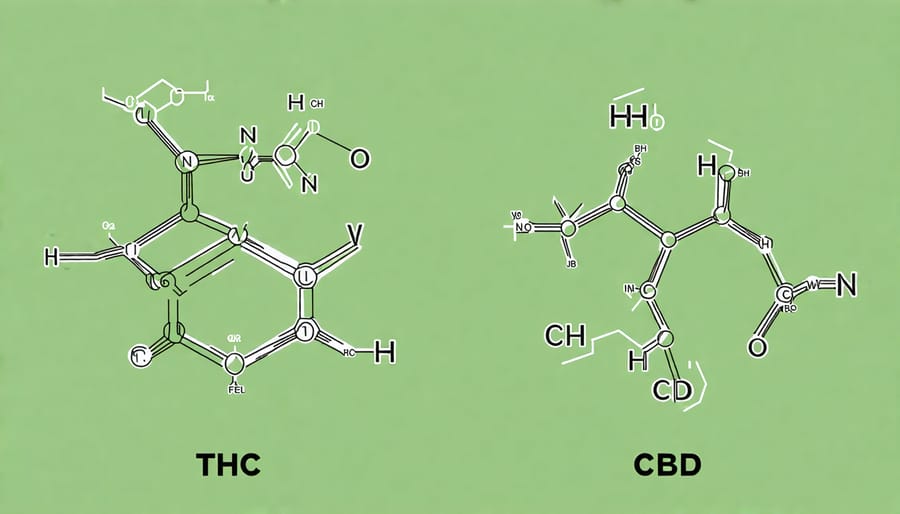Explore the soothing effects of kratom by starting with strains like the strongest trainwreck kratom, known for its potent opioid-like relief that supports pain management and mental clarity. Pair it with sativa-dominant cannabis strains to elevate mood and increase focus; begin with small doses to understand personal tolerance. Ensure compliance with Canadian legalities by purchasing through licensed dispensaries, keeping each product’s legality transparent and accessible. Finally, track your experiences in a journal to recognize synergies, aiding informed decisions for future use.
Understanding Kratom

Origins and Background
Kratom and cannabis have long histories steeped in traditional use across various cultures. Originating in Southeast Asia, kratom has been utilized for generations by local communities in countries like Thailand, Malaysia, and Indonesia. Traditionally, kratom leaves were chewed or brewed into teas to combat fatigue, alleviate pain, and enhance work efficiency. It played an integral role in social and ceremonial settings, showcasing its cultural significance. Meanwhile, cannabis has a diverse history stretching back thousands of years, with uses spanning from medicinal to spiritual across numerous civilizations. Native to Central and South Asia, cannabis found a place in ancient Chinese medicine and was revered in India for its spiritual connections. Today, both plants continue to capture interest for their natural remedy potential, sparking curiosity about their effects and applications in modern wellness practices.
Active Compounds and Effects
Kratom is composed of various active alkaloids, with mitragynine and 7-hydroxymitragynine being the most prominent. These natural compounds interact with the body by binding to opioid receptors in the brain, potentially offering pain relief, relaxation, and mood enhancement. Mitragynine is noted for its energizing effects, which can foster alertness and focus, often described as similar to caffeine but with a unique profile. Conversely, 7-hydroxymitragynine tends to have more sedative properties, aiding in stress relief and promoting a sense of calm. The effects vary based on dosage and individual body chemistry, necessitating informed and cautious use. Additionally, understanding how kratom’s alkaloids may synergize with cannabis compounds, like THC and CBD, can help users achieve desired outcomes safely and effectively, while adhering to Canadian regulations.
Cannabis in Natural Medicine
THC vs. CBD
In the realm of cannabis, the two primary compounds often discussed are THC (tetrahydrocannabinol) and CBD (cannabidiol). While both are found in cannabis plants, their effects and benefits differ significantly, offering unique health advantages to users. THC is renowned for its psychoactive properties, which produce the “high” commonly associated with cannabis. This compound can help with pain relief, appetite stimulation, and mood enhancement, making it a popular choice for those seeking an uplifting experience.
On the other hand, CBD is celebrated for its therapeutic potential without causing euphoria. Many adults in Canada turn to CBD for its calming effects, which can promote relaxation and support mental well-being. Moreover, CBD is praised for its anti-inflammatory properties, which aid in managing chronic pain and anxiety without the side effects of THC. As interest grows, various Top CBD Brands offer diverse product options, allowing users to explore these natural remedies. Embracing CBD might be a gentle step for beginners and a valuable addition for seasoned cannabis enthusiasts.

Cannabis Uses in Health Management
Cannabis has become an integral part of modern health management, offering potential relief for a variety of conditions. Known for its therapeutic properties, cannabis can help manage chronic pain, with many adults reporting significant reductions in discomfort. It’s also gaining attention for its potential to alleviate symptoms of anxiety and depression, offering a more natural alternative to traditional pharmaceuticals. Moreover, cannabis is utilized in the management of sleep disorders like insomnia, providing users with a non-habit-forming option that can promote restful sleep. In Canada, where legal regulations support its use, there is a focus on responsible consumption and understanding the diverse effects of different strains. Curious individuals can explore the Best THC Brands to find reputable options that suit their needs. By fostering an educated community, Canadians can make informed decisions about integrating cannabis into their wellness routines, always staying mindful of legal guidelines and personal health requirements.
Synergies Between Kratom and Cannabis
Complementary Benefits
Combining kratom and cannabis can offer a complementary range of benefits, enhancing the natural therapeutic effects each plant has to offer. While kratom is known for its pain-relieving and energy-boosting properties, cannabis, particularly with its cannabidiol (CBD) component, is often used for relaxation and relieving anxiety. Together, these plants may provide a holistic approach to managing discomfort and stress. For instance, for those exploring CBD for anxiety, incorporating kratom may help address physical pain or lethargy simultaneously. However, it’s essential to approach this combination mindfully and responsibly, considering each individual’s unique response and legal guidelines in Canada. Consulting with a healthcare professional experienced in natural remedies can further guide effective and safe usage, fostering a more informed community of users seeking natural solutions.

Safety and Responsible Usage
Using kratom and cannabis together requires careful consideration to ensure safety and maximize benefits. Start with low doses to gauge individual reactions, as both substances can affect the central nervous system. It’s important to be aware of potential interactions, especially since kratom and cannabis can have sedative effects. Avoid driving or operating heavy machinery after using these substances. It’s essential to source both kratom and cannabis from reputable suppliers to ensure purity and quality. Consult with healthcare professionals before combining these remedies, particularly if you have pre-existing medical conditions or take other medications. Adhering to Canadian legal regulations is crucial, as both kratom and cannabis are subject to specific laws. By practicing mindful and responsible usage, adults can explore these natural remedies safely and effectively.
Legal Considerations in Canada
Kratom Regulations
In Canada, kratom’s legal status is somewhat ambiguous. Currently, kratom is not approved for sale as a consumable product due to Health Canada’s regulations, which classify it as a natural health product. However, unlike cannabis, which has a clear legal framework for adult use, kratom’s regulatory situation remains largely undefined, meaning it’s often sold as a non-ingestible item, like a herbal remedy for aroma therapy. This leaves potential users in a confusing landscape, emphasizing the importance of staying informed about evolving laws and conducting thorough research before considering kratom as a supplement.
Cannabis Laws
In Canada, the legal framework for cannabis use and distribution is governed by the Cannabis Act, which came into effect in October 2018. This legislation was groundbreaking, making Canada one of the first major nations to legalize recreational cannabis use. Adults aged 18 or 19, depending on the province, can possess up to 30 grams of legal cannabis in public, purchase it from licensed retailers, and cultivate up to four plants per household for personal use. However, local regulations may vary, and it’s crucial for users to acquaint themselves with provincial rules. Understanding these laws fosters responsible consumption and supports a well-informed community of cannabis users.
Real-Life Experiences and Testimonials
Navigating the landscape of natural remedies often leads individuals to explore the potential of kratom and cannabis. Many adults in Canada have shared their personal stories, highlighting the transformative impact these plants have had on their well-being. Emily, a graphic designer from Toronto, turned to cannabis after struggling with chronic pain from repetitive stress. She shares how a balanced approach, incorporating both CBD and THC strains, significantly alleviated her symptoms and improved her quality of life. This experience inspired her to delve deeper into the diverse Cannabis brands available and find products that suited her lifestyle and needs.
Similarly, Michael, a recent retiree, turned to kratom after battling years of anxiety. He found that kratom provided a gentle, calming effect that helped him regain control and enjoy his retirement. Both Emily and Michael emphasize the importance of responsible usage, understanding the distinct properties of each plant, and remaining informed about legal guidelines in their area.
These real-life experiences reflect a broader community keen on exploring natural solutions while fostering informed discussions and support networks. By sharing stories and testimonials, we offer insights into how these remedies can fit into everyday life, encouraging others to consider their potential benefits responsibly.
Conclusion
In summary, exploring the potential of kratom and cannabis can provide valuable insights into their therapeutic benefits and complementary uses. Throughout this article, we highlighted how both substances offer natural relief for various conditions and discussed their unique properties. For Canadians curious about integrating these remedies into their wellness routines, understanding their effects, safe usage, and legal standing is crucial. Given the dynamic landscape of natural health solutions, kratom and cannabis present intriguing possibilities for enhancing well-being when used responsibly. As with any substance, personal experiences may vary, so it’s essential to approach their use with an informed mindset and respect for individual tolerance levels. By fostering a community of well-informed users, we can better navigate the potentials and limitations of these natural remedies, promoting responsible choices and open dialogue. With continued education and mindful exploration, kratom and cannabis might just be the key to unlocking a balanced approach to natural health.




